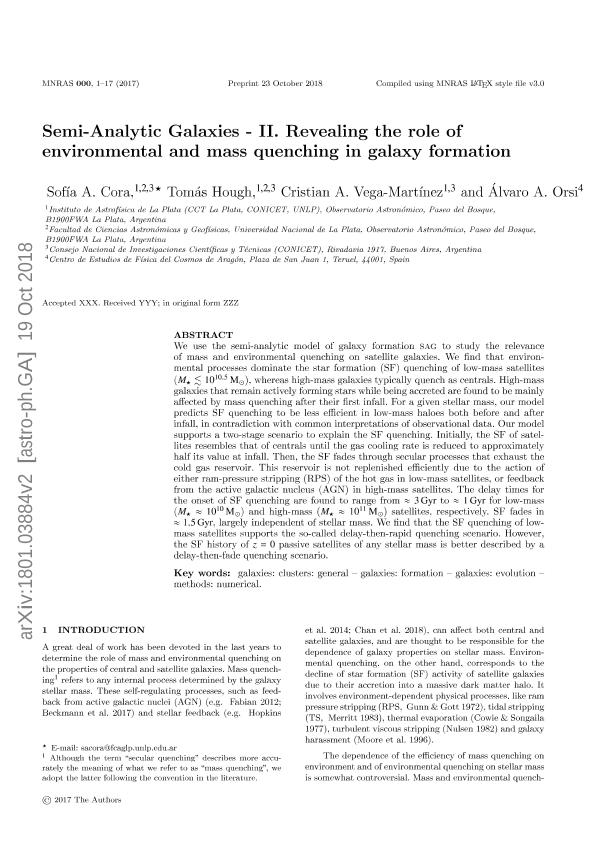Mostrar el registro sencillo del ítem
dc.contributor.author
Cora, Sofia Alejandra

dc.contributor.author
Hough, Tomas

dc.contributor.author
Vega Martínez, Cristian Antonio

dc.contributor.author
Orsi, Álvaro A.
dc.date.available
2020-10-22T17:36:47Z
dc.date.issued
2019-01
dc.identifier.citation
Cora, Sofia Alejandra; Hough, Tomas; Vega Martínez, Cristian Antonio; Orsi, Álvaro A.; Semi-analytic galaxies - II. Revealing the role of environmental and mass quenching in galaxy formation; Wiley Blackwell Publishing, Inc; Monthly Notices of the Royal Astronomical Society; 483; 2; 1-2019; 1686-1700
dc.identifier.issn
0035-8711
dc.identifier.uri
http://hdl.handle.net/11336/116346
dc.description.abstract
We use the semi-analytic model of galaxy formation sag to study the relevance of mass and environmental quenching on satellite galaxies. We find that environmental processes dominate the star formation (SF) quenching of low-mass satellites (M? . 1010.5 M ), whereas high-mass galaxies typically quench as centrals. High-mass galaxies that remain actively forming stars while being accreted are found to be mainly affected by mass quenching after their first infall. For a given stellar mass, our model predicts SF quenching to be less efficient in low-mass haloes both before and after infall, in contradiction with common interpretations of observational data. Our model supports a two-stage scenario to explain the SF quenching. Initially, the SF of satellites resembles that of centrals until the gas cooling rate is reduced to approximately half its value at infall. Then, the SF fades through secular processes that exhaust the cold gas reservoir. This reservoir is not replenished efficiently due to the action of either ram-pressure stripping (RPS) of the hot gas in low-mass satellites, or feedback from the active galactic nucleus (AGN) in high-mass satellites. The delay times for the onset of SF quenching are found to range from ≈ 3 Gyr to ≈ 1 Gyr for low-mass (M? ≈ 1010 M ) and high-mass (M? ≈ 1011 M ) satellites, respectively. SF fades in ≈ 1.5 Gyr, largely independent of stellar mass. We find that the SF quenching of lowmass satellites supports the so-called delay-then-rapid quenching scenario. However, the SF history of z = 0 passive satellites of any stellar mass is better described by a delay-then-fade quenching scenario.
dc.format
application/pdf
dc.language.iso
eng
dc.publisher
Wiley Blackwell Publishing, Inc

dc.rights
info:eu-repo/semantics/openAccess
dc.rights.uri
https://creativecommons.org/licenses/by-nc-sa/2.5/ar/
dc.subject
GALAXIES: EVOLUTION
dc.subject
GALAXIES: FORMATION
dc.subject
GALAXIES: HALOES
dc.subject
METHODS: NUMERICAL
dc.subject.classification
Astronomía

dc.subject.classification
Ciencias Físicas

dc.subject.classification
CIENCIAS NATURALES Y EXACTAS

dc.title
Semi-analytic galaxies - II. Revealing the role of environmental and mass quenching in galaxy formation
dc.type
info:eu-repo/semantics/article
dc.type
info:ar-repo/semantics/artículo
dc.type
info:eu-repo/semantics/publishedVersion
dc.date.updated
2020-09-25T16:53:16Z
dc.journal.volume
483
dc.journal.number
2
dc.journal.pagination
1686-1700
dc.journal.pais
Reino Unido

dc.journal.ciudad
Londres
dc.description.fil
Fil: Cora, Sofia Alejandra. Consejo Nacional de Investigaciones Científicas y Técnicas. Centro Científico Tecnológico Conicet - La Plata. Instituto de Astrofísica La Plata. Universidad Nacional de La Plata. Facultad de Ciencias Astronómicas y Geofísicas. Instituto de Astrofísica La Plata; Argentina. Universidad Nacional de La Plata. Facultad de Ciencias Astronómicas y Geofísicas. Observatorio Astronómico de La Plata - Sede Central; Argentina
dc.description.fil
Fil: Hough, Tomas. Consejo Nacional de Investigaciones Científicas y Técnicas. Centro Científico Tecnológico Conicet - La Plata. Instituto de Astrofísica La Plata. Universidad Nacional de La Plata. Facultad de Ciencias Astronómicas y Geofísicas. Instituto de Astrofísica La Plata; Argentina. Universidad Nacional de La Plata. Facultad de Ciencias Astronómicas y Geofísicas. Observatorio Astronómico de La Plata - Sede Central; Argentina
dc.description.fil
Fil: Vega Martínez, Cristian Antonio. Consejo Nacional de Investigaciones Científicas y Técnicas. Centro Científico Tecnológico Conicet - La Plata. Instituto de Astrofísica La Plata. Universidad Nacional de La Plata. Facultad de Ciencias Astronómicas y Geofísicas. Instituto de Astrofísica La Plata; Argentina
dc.description.fil
Fil: Orsi, Álvaro A.. Centro de Estudios de Física del Cosmos de Aragón; España
dc.journal.title
Monthly Notices of the Royal Astronomical Society

dc.relation.alternativeid
info:eu-repo/semantics/altIdentifier/doi/http://dx.doi.org/10.1093/mnras/sty3214
dc.relation.alternativeid
info:eu-repo/semantics/altIdentifier/arxiv/https://arxiv.org/abs/1801.03884
dc.relation.alternativeid
info:eu-repo/semantics/altIdentifier/url/https://academic.oup.com/mnras/article-abstract/483/2/1686/5212312?redirectedFrom=fulltext
Archivos asociados
